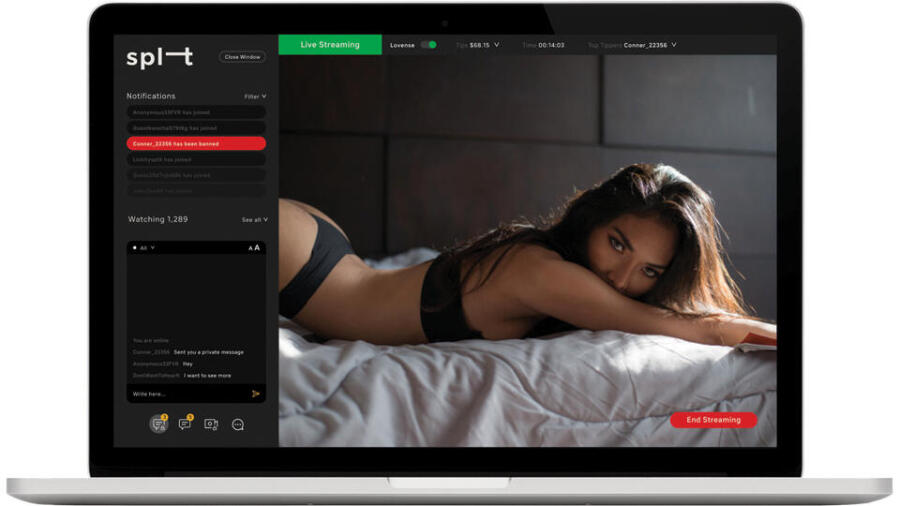Enabling performers to broadcast live streams to multiple sites simultaneously, adult cam-splitting solution SPLTstream.com is on a mission to make models’ lives easier, while also making them more money from their existing show schedule.
This simple-to-use software lets models reach a broader audience while supporting the newest trends across select sites, including Lovense and gaming integration.
SPLT allows users to utilize the tools they are already accustomed to, from one central dashboard for a more streamlined user experience.
Real-time tip monitoring, comprehensive analytics and the ability to manage all fans from one screen make it easier for models to reach and interact with more visitors, without having to bounce back and forth between multiple interfaces.
Thanks to SPLT, it has never been easier or more productive for models to benefit from cam-splitting and the diversity of audiences that different cam sites can deliver.
For greater insights into SPLT’s approach to cam-splitting and more, XBIZ turned to company co-founder John Katt. Here’s what he had to share:
XBIZ: What is cam-splitting and what are the benefits?
Katt: Cam-splitting is when you use software to broadcast across multiple webcam sites simultaneously. The benefit of this software is that it provides users with the opportunity to have an active profile on multiple sites, reach a broader audience and increase their earnings from the same amount of stream time. The benefit of SPLT is having a centralized, user-friendly interface that gives users the ability to manage all of their fans from one window while streaming — and with a robust set of features and analytics at their fingertips.
XBIZ: What makes other methods of cam-splitting less ideal than using SPLT?
Katt: Generally speaking, software that is adapted from other industries — gaming, for example — can be complicated and difficult to use. It doesn’t integrate directly with cam sites, has no centralized hub or dedicated features and often requires significant investment in hardware, whether it’s a super-powerful computer, multiple screens and cameras, or an impractical amount of bandwidth.
With SPLT, we’ve built something specifically tailored to the adult camming industry from the ground up. Plus, all you need is a capable laptop or desktop, a camera and mic and a reliable internet connection.
XBIZ: How does cam-splitting impact bandwidth usage and how does SPLT help?
Katt: Until now, splitting has meant an increased demand on broadcasters’ bandwidth with every additional site they stream to. That means users have to limit the number of fans they reach unless they have high-speed upload capacity.
We designed our software so that a user’s bandwidth doesn’t get divided. On SPLT’s platform, it doesn’t matter whether they’re streaming to four or eight sites — it will be as if they are only streaming to one.
XBIZ: Is there a limit to the number, or brand, of sites that SPLT supports? What about a limit on the number of fans at any given time?
Katt: We thoughtfully chose four sites for our launch because of the feedback we received from the performers we surveyed. Our phase-one integration will include Chaturbate, CamSoda, CAM4 and BongaCams. Currently, we are only integrating with public sites, but we plan to integrate with more — both public and private — in future versions.
There are challenges to combining public and private entities on one platform because of differing practices. For example, private sites only allow models to be nude after the stream is private, which isn’t the case with public sites. But it’s something that our team is working on and we hope to offer up to eight sites by 2021, with the sites added in phase two determined by what performers tell us they want.
The thing that is important to us at the moment — even more than the number of sites we support — is that we are working to cultivate a mutually beneficial relationship between SPLT, performers and cam companies, with a focus on quality over quantity.
While our primary objective has always been to support the performer, we see many ways in which SPLT can add value for the cam sites as well. We are the new kid on the block, and while we hope to transform the industry in terms of creating broader access for performers, our goal is not to take business away from anyone. We want to effect positive change on every level, and once we have established who we are and how we work, we will turn our focus to further integration and more features, so the possibilities are endless. As for the number of fans, there is no limit.
XBIZ: How can SPLT help models generate more revenue? What types of reporting or stats does SPLT provide? Does SPLT offer mobile support for on-the-go broadcasters? What about VR?
Katt: SPLT is built on the same fundamental concept that all cam-splitting software is based on: By streaming to more than one site at once, you can broaden your audience and increase your profits without increasing your efforts. But, SPLT takes it a few steps further.
When you are cam-splitting and trying to manage chats, play games, stream privately, track tips and more for multiple sites in separate windows all at the same time, it can be challenging to say the least. SPLT allows users to utilize the tools they are already accustomed to, from one central dashboard for a more streamlined user experience. By simplifying the process and making it more efficient, we hope to give users more control over their success.
Analytics is a powerful part of the platform that will help users track when they are the most profitable, helping them to strategize. Users will be able to generate reports of their income, filtered by the hour, day, week and month, and can also compare their stats from past live streams.
Users can also view a breakdown of earnings by cam site to see where their audience is coming from, and monitor their top tippers because knowing the customer base is a huge part of maximizing revenue. And what’s more, everything is displayed in actual dollar amounts, rather than in tokens.
For broadcasters on the go, we plan to have mobile support by the end of 2020, and for fantasy-seekers, VR capabilities by 2021.
XBIZ: The integration of pleasure products and gaming is growing. Does SPLT support these ancillary facets of camming?
Katt: We currently support all Lovense toys and intend to integrate other pleasure products into the SPLT ecosystem in future versions.
XBIZ: What do models need to utilize SPLT?
Katt: Let’s start with the basics. Users will need a computer, webcam, microphone and high-speed internet access — no dial-up. We also recommend using the newest technology available, since anything users can do to increase the quality of their stream will provide customers with a better show, which translates into higher profits for performers.
This means using a high-definition webcam and a high-quality microphone, and a computer that is capable of streaming to at least one site. If possible, an ethernet cable should be used, rather than streaming over Wi-Fi, as it will boost the upload capability significantly.
Users will also need to have an active account with the cam sites that they wish to stream to. To open and activate an account with these sites, models will need to provide a copy of their government-issued ID to verify their age and identity. Once they’ve completed the registration process, they can connect all of their accounts by adding the necessary login info to the SPLT dashboard.
XBIZ: How much does SPLT cost?
Katt: We decided to offer SPLT as a subscription rather than as a commission-based service because we wanted to provide this resource for a fair, fixed monthly fee that people can budget for, rather than dealing with a sliding-scale cost. The price ranges from $50 to $100 per month, depending on the number of sites that users stream to and the features they choose to utilize.
XBIZ: What is in the pipeline for SPLT in terms of development and new features?
Katt: The biggest project currently in development is the mobile version of SPLT, which will permit models to stream from anywhere. Beyond that, we plan to focus on enhancing our analytics, integrating with more cam sites, both public and private, as well as adding more language options.
Our long-term goal is to become a central hub for everything broadcasters need to become successful in the industry. We want to make it possible to post videos and share photos to third-party membership sites, as well as manage social media feeds, right from the SPLT dashboard. We also want to create an interface for studios that manage multiple models, so that they can have access to all of the powerful features and analytics that SPLT offers.








